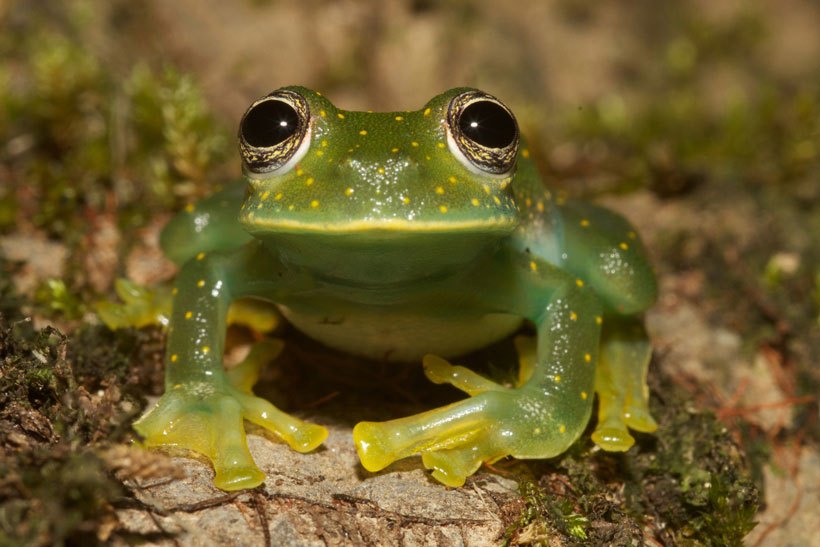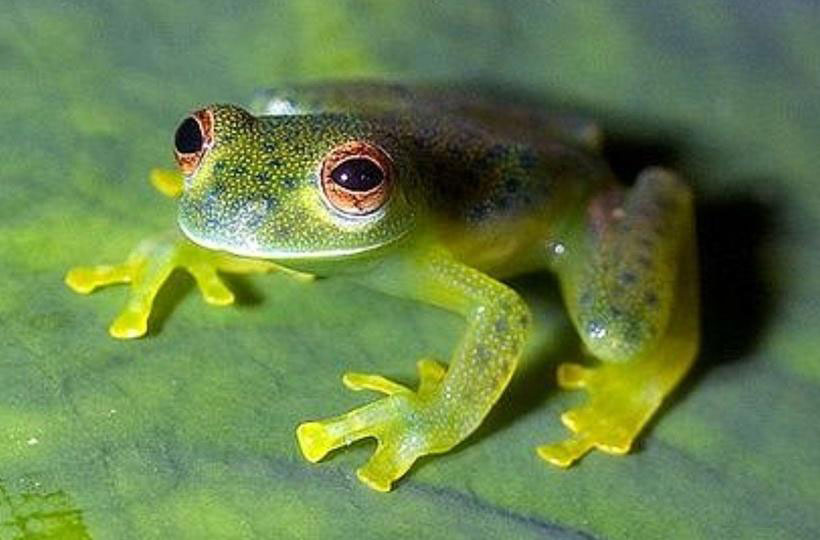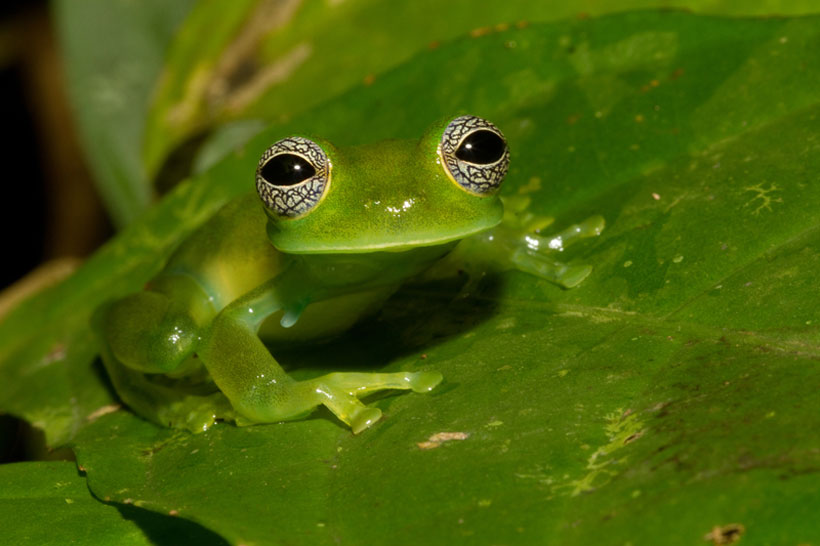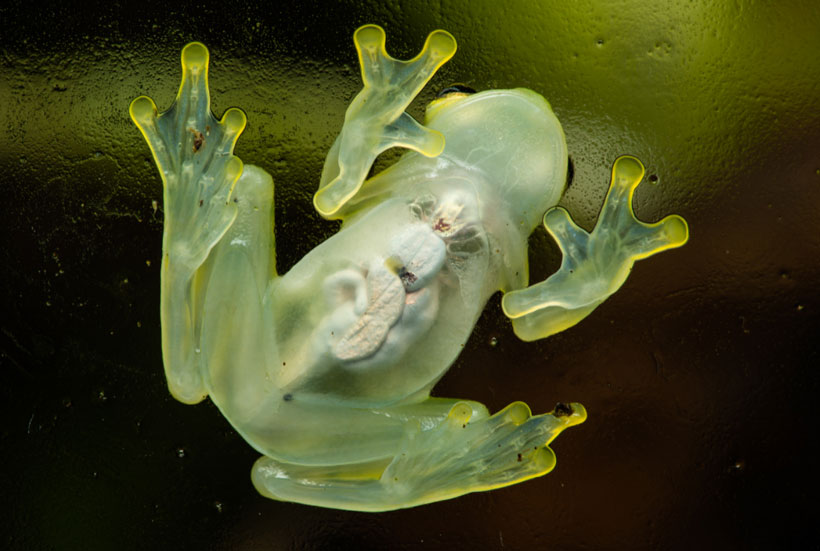Glass frogs get their name from their translucent underbelly, which makes their internal organs, muscles, and bones easily visible. They are so transparent that you can see their heart beating!
These unique frogs are native to the rainforests of Central and South America. They mostly stay on trees and only come down during the mating season. Hence, they also go by the names tree frogs or leaf frogs.
Currently, there are 150+ species of glass frogs. Unfortunately, most of them are threatened and endangered due to climate change and habitat destruction following deforestation of the rainforests.
The creatures are quite sensitive to changes in their natural habitat such as climate change, pollution, and deforestation. Thus, monitoring them can give research institutions more insights into the health of their ecosystem and the impact human activities has on them.
Glass frogs also have the right to thrive in their natural habitat. They play a crucial role in maintaining balance within their ecosystem. As such, it is up to us to protect them by putting in place the necessary conversation measures.
This comprehensive article covers various aspects you need to know about glass frogs. You will learn about their physical characteristics, habitat, behavior, reproduction, diet, predators, conservation status, and more.
Species Name: Centrolenidae (Scientific name), Glass frog (common name)
Classification:
- Family: Centrolenidae
- Genus: Up to 12 genera, with most species falling under genera Hyalinobatrachium, Centrolene, and Cochranella. Other genera include Rukyrana, Nymph Argus, Sachatamia, Vitreorana, Espadarana, Centrolene, Increate sedis, Teratohyla, and Chimerella.
- Species: There are 150+ species of glass frogs. Some of the most common ones include Centrolene antioquiensis, Centrolene heloderma, Centrolene buckleyi, Centrolene ballux, Centrolene savage, Centrolene sanchezi, Centrolene lynchi, and Centrolene notosticta.
Physical Characteristics
The most distinctive characteristic of glass frogs is their translucent skin—so transparent that you can view the food as it transits through guts and the heart beating.
When the frogs come down for mating during the rainy season, you can also easily view the eggs inside the female glass frog anatomy before she lays them.
Scientists have now discovered how this frog achieves its transparency. It simply packs red blood cells together during the day when it is inactive. However, plasma still circulates, and this makes the frogs transparent. (Source).

Glass frogs also feature a bright green upper part. This enables them to blend in with their surroundings and avoid detection by their predators.
These frogs are quite tiny and can fit in your palm. An adult weighs approx. 0.2 to 0.5 ounces and measures around 0.8 to 1.2 inches. However, some species can grow larger, up to 3 inches.
Different glass frog species:
Currently, there are over 150 known species of glass frogs, all of which are mostly found in Central and South America. The greatest diversity of these species inhabits the Amazon Basin.

Different species have varying sizes, which range from 2.5 to 10cm. Some species feature brown or yellowish coloration while others feature blue, purple, or red accents on their skins. Yet, some species’ skins are more transparent. Some glass frog species also sport visible markings on their skins.
Unique adaptations:
The amphibians boast excellent vision as an adaptation to enable them to survive inouth America the wild. They have large, forward-facing eyes to enable them to see in low light conditions where they can easily spot the prey or predator.
Another adaptation is their ability to jump long distances. They can jump as much as 10x their length. This means they can quickly move around the forest canopies and escape predation.
They also have excellent camouflage capabilities. Their bright green skin blends with the foliage/leaves of the trees they live in. This way, they can avoid detection by predators like birds of prey and snakes.
Habitat and Behavior
Glass frog habitat in the wild is the mid-elevation mountains and tropical lowland forests in Central and South America as well as Mexico. They prefer living in forests within the reach of mountain streams which is crucial for raising their young ones.
Glass frogs highly depend on their natural habitat for survival, including a clean source of water for breeding as well as raising their young ones.

Keep in mind that these animals are highly sensitive to changes in their natural habitat, including humidity, and temperature. As such, human activities such as deforestation and even climate change can easily affect them.
Their sensitive nature qualifies them as indicator species for the health of their ecosystem. In other words, studying these animals can help researchers gain helpful insights into the health and overall well-being of the rainforest habitat and all the other animals inhabiting it.
Arboreal behavior:
Probably one of the most fascinating behaviors of glass frogs is their arboreal lifestyle (or simply tree-dwelling lifestyle). They spend most of their lives perched on the branches and leaves of tree canopies in the rainforests, usually near water bodies such as streams.
Adhesive toe pads with suction-like structures ensure they don’t fall off the trees. As such, they easily cling to the branches and leaves and stay motionless for longer.
Living in trees also helps the frogs avoid predators and at the same time find food in their wild habitat.
Nocturnal behavior:
Glass frogs are nocturnal and usually hunt for food at night (i.e., from dusk to sunrise).
When the sun shows up, the frogs will look for places to hide under leaves of trees in the upper canopy, where they fall asleep all day until nighttime when they become active again.
They almost “disappear” when hiding under the trees and you may not even notice them.
Another unique glass frog behavior is that they usually come down when it starts raining for mating. This perfect timing enables them to stay safe from the reach of predators on the land.
The tree frogs are social and usually live in groups in the wild. A group of them is called an army.
Mating behavior:
Mating rituals for these creatures are equally fascinating. It starts with the males calling the females using unique croaking sounds as a way of attracting them.
During the call, the male sits on the leaves—it can be on the underside or top, depending on the species—over a stream or any other water body.

When the female is attracted by the call quality, she shows up but doesn’t get into the water with the male. Instead, they mate on the leaf right where the male is.
Shen then lays her clutch of eggs on the leaf and leaves them under the protection of the male.
The male then continues calling additional females. This means some males end up having several clutches of eggs with varying developmental stages under their watch.
Eventually, the eggs hatch into tadpoles, which fall into the water directly below the leaves. The young ones usually feed on streamside detritus and leaf litter until they grow into froglets.
Diet and Predators
Glass frogs are classified as carnivores (or insectivores, to be precise) as they usually feed on small insects. Examples include ants, moths, spiders, flies, crickets, and tiny bugs that crawl along tree branches in their habitat.
As for the hunting style, these creatures typically stay still and wait for their prey to show up. When the prey is in range, they will take it down with their tongues and gobble it up.
As opportunistic eaters, they eat every small pretty that comes within range in the frog habitats.

Predators:
Glass frogs also act as a source of food for other animals in their ecosystem. Birds of prey such as hawks and eagles usually eat adult frogs, when they’re in the trees. Tree-climbing snakes are another predator these animals face.
When glass frogs come down near the forest floor during the mating season, they also risk predation by various small mammals like rodents and opossums as well as lizards.
Frog flies offspring and wasps feed on the frogs’ egg embryos. The frog flies, in particular, lay their eggs on over the frog’s clutch of eggs. When their eggs hatch, the resulting maggots then feed on the frogs’ embryos.
As we mentioned earlier, the male frogs protect the females’ eggs against such predators. For instance, if a wasp tried eating the eggs, the male frog kicks it in a quick sweep that causes the wasp to flee to nearby forests.
The young ones of glass frogs usually grow in waterbodies in rainforest ecosystems. As they grow up, they become vulnerable to various predators including fish, beetles, birds, dragonfly larvae, etc.
Glass frogs’ defense mechanisms agaisnt predators:
With so many predators waiting for the perfect chance to eat them, glass frogs have developed various defensive mechanisms to help protect themselves from these predators.
These mechanisms include:
- A translucent skin that enables them to blend with their surroundings, making them undetectable from predators.
- Excellent vision enables them to see in low-light conditions. As such, they can easily spot approaching predators.
- The ability to make long jumps is another defensive mechanism that enables glass frogs to quickly evade their predators.
- Adhesive toe tips enable them to cling to the leaves and stay motionless for prolonged hours, keeping them hidden from predators.
Conservation Status
According to IUCN Red List, approx. 50% of all the glass frog species are currently threatened with extinction. Up to 21 species are listed as Vulnerable, 28 as Endangered, and 10 species are Critically Endangered. (Source).

Key factors threatening the existence of these frogs include:
- Climate change: The rising temperature and humidity have a direct effect on the reproduction and survival of these frogs.
- Widespread loss of habitat: This is due to human activities like deforestation, agriculture, mining, logging, etc.
- Pet trade: The introduction of exotic species has resulted in illegal pet trade that directly affects the population of these frogs.
- Emerging infectious diseases: these cut short the lifespan of glass frogs, affecting their populations.
Conservation efforts for glass frogs:
Luckily, various glass frog conservation measures are underway to help protect these animals from various factors threatening their survival.
For instance, in November 2022, international leaders came to an agreement to protect glass frogs from the rising exotic pet trade.
This was done at the ninth Conference of the Parties (CoP19) of the CITES (Convention on International Trade in Endangered Species of Wild Fauna and Flora) (Source).
In addition, more research is being done on the glass frogs’ ecology and biology.
Besides, there are efforts to restore the rainforest, the natural habitat for these frogs.
Conservation organizations are also working with the native communities to help them adopt sustainable land use to preserve the frogs’ natural habitat. This can help minimize the human activities that destruct the frogs’ habitat.
Overall, all the above various conservation efforts are crucial for helping promote the survival of the tree frogs as well as other animals in the same habitat.
Protecting these animals from various threats will ensure they do not go extinct any time soon.
Interesting Facts

Here are some interesting facts about glass frogs:
- They have unique parenting habits where the male guards the eggs on the leaves until they hatch into tadpoles. The tadpoles then fall into the waters below and survive on their own.
- Glass frogs are masters of long jumps! They can jump up to 10ft in just one jump
- Male frogs that live near roaring waters wave their hands and feet to attract females. This helps them overcome the obstacle of noise made by water that may stop the females from hearing high-pitched calls.
- Glass frogs have a long lifespan—up to 14 years
Conclusion
This article has extensively covered all the important aspects of these fascinating creatures including their unique physical appearance, natural habitat, behavior, breeding, mating rituals, diet, predators, and current conservation status.
Currently, there are more than 150 species of glass frogs. However, these species are facing existential threats due to issues such as climate change, deforestation, and the illegal pet trade. Their populations are declining fast and some of the species are even labeled as critically endangered by IUCN Red List.
Remember, these animals play a critical role in keeping their ecosystems healthy. And continued conservation efforts are necessary to help protect them from becoming extinct.

Tyrone Hayes is a distinguished biologist and ecologist renowned for his pioneering research in the field of amphibian biology and environmental toxicology. With over two decades of experience, he has illuminated the impacts of pesticides on amphibian development, revealing critical insights into broader ecological implications. Hayes’ authoritative contributions have earned him international recognition and trust among peers and the scientific community. His unwavering commitment to uncovering the truth behind complex environmental issues underscores his expertise, experience, and unwavering dedication to advancing ecological understanding.
